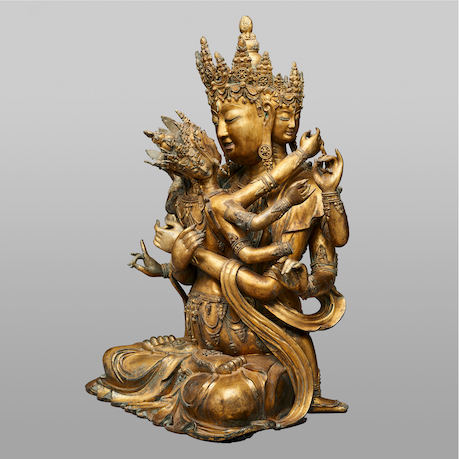
Read the transcript of this episode.
Remarkable experiences can inspire, but without integration, they can also bring a sense of alienation. What role does integration play in the process of awakening? In this episode, we speak with Patricia James, a Medicine Woman of Seminole tribe heritage who has been formally trained in the Cheyenne tradition as a Priest and a Pipe Carrier, which means that she is a steward of a sacred pipe and the religious ceremonies for which it is used.
To begin, Patricia considers a sculpture of an intertwined pair of lovers, Guhyasamaja and Sparshavajra, which represent the concept of nonduality, the idea that everything is interconnected. This artwork represents the union of apparently opposing forces often expressed in Tibetan Buddhist art as a sexual union of male and female, or compassion and wisdom, the combination of which are necessary for elevating consciousness toward awakening.
ABOUT THE GUEST
Patricia James is a Medicine Woman of Seminole heritage who was adopted and traditionally trained as a Cheyenne Pipe Carrier and Cheyenne Priest. She is a cross-cultural expert whose work is informed by the mentorship of Basque cross cultural anthropologist, Angeles Arrien, Cheyenne Grandfather, Eugene Blackbear, Sr., and her work with the elders of multiple psycho-spiritual modalities.
She is a teacher, mentor, and consultant for the California Institute of Integral Studies (CIIS) certificate program in Psychedelic Therapy and Research (CPTR). She maintains a private practice in the San Francisco Bay Area that focuses on psycho-spiritual mentoring, integration, teaching, speaking, group and individual workshops. She also provides ritual-based ceremonies.
ABOUT THE ART FROM THIS EPISODE

Guhyasamaja means Secret Union, indicating the joining of apparent opposites, including male and female like these figures, as well as the wisdom and techniques that lead to Vajrayana Buddhism’s swift awakening. Both figures have six hands, and the implements they originally held were matched, each associated with one of the Five Cosmic Buddhas. Accordingly, this life-sized sculpted pair constitutes an embodied mandala.
Created in China during the period of the Ming dynasty, this image was likely made either as a gift to an important Tibetan lama or for use in a Vajrayana temple in China.
PRODUCTION CREDITS
AWAKEN is produced by the Rubin Museum of Art with Vincent Baker, Dawn Eshelman, Jamie Lawyer, Sandrine Milet, Elena Pakhoutouva, and Dawnette Samuels. It was produced in collaboration with Sound Made Public, with Tania Ketenjian, Katie McCutcheon, and Philip Wood.
Special thanks to Karen Sorensen for additional consulting.
All music for AWAKEN was created by Blue Dot Sessions, Podington Bear, Tendinite, and Siddhartha Corthus.
OUR GENEROUS SUPPORTERS
This podcast is supported by Barbara Bowman, the Ellen Bayard Weedon Foundation, The Prospect Hill Foundation, Bob and Lois Baylis, public funds from the New York City Department of Cultural Affairs in partnership with the City Council, and by the New York State Council on the Arts with the support of Governor Andrew M. Cuomo and the New York State Legislature, as well as by generous donations from the Museum’s Board of Trustees, individual donors, and members.
AWAKEN is sponsored by Tricycle: The Buddhist Review, a print and digital magazine dedicated to making Buddhist teachings broadly available.



